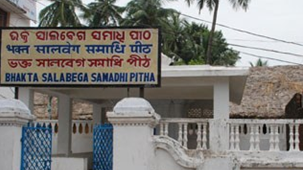

BHUBANESWAR, ODISHA - In an extraordinary display of divine love that transcends religious boundaries, Lord Jagannath's magnificent chariot makes a symbolic halt every year during the world-famous Rath Yatra at the tomb of Salabega, a 16th-century Muslim devotee whose unwavering faith earned him eternal recognition from the deity himself.
Located on the Grand Road near Balagandi Chata Matha in Puri, Salabega's samadhi (tomb) becomes a focal point of reverence during the annual Rath Yatra when the chariot of Lord Jagannath stops for a while near this sacred spot, marking tribute to this immortal devotee. This centuries-old tradition continues to exemplify the universal nature of divine love, proving that devotion knows no religious barriers.
Born on September 16, 1592 (Radhashtami), Salabega was the son of Lalbeg, a Muslim warrior who served under Raja Man Singh in the Mogul army. Despite his Islamic upbringing, Salabega's heart was captured by Lord Jagannath, leading him to become one of Odisha's most celebrated devotional poets.
The devotee's spiritual journey reached its pinnacle during one particular Rath Yatra when the chariot of Lord Jagannath came closer to the house where Salabega was staying, he started weeping, and suddenly the chariot stopped there. Salabega made darshan of The Lord very happily and after that, the chariot started moving.
After his death, Salabega's body was cremated at the same location where Jagannath's cart had stopped, the spot where he had composed many bhajans in honor of the deity. His body miraculously turned into a heap of fragrant flowers, and his Samadhi was situated in Balagandi, near the Balagandi Chata Matha of the Ramanandi Sampradaya.
The devotee's literary contributions to Jagannath worship remain significant, with Salabega writing at least 150 songs on Jagannatha, including his famous bhajan "Ahe Nila Saila" which continues to resonate with devotees today.
Every year during the Rath Yatra, as the chariots roll down about 200 meters on Grand Road, they make a symbolic stop in front of the Mazar (tomb). This story serves as a reminder that Lord Jagannath is a merciful God who loves all of his devotees, regardless of their religion or background.
The practice represents more than just tradition; the ritual halt of Lord Jagannath's chariot at Salabeg's tomb is a reminder of universality of deity-devotee relation. This annual occurrence during the nine-day festival journey from the main temple to Gundicha Temple demonstrates that divine grace flows equally to all sincere hearts.
The Salabega tradition has become a powerful symbol of India's pluralistic spiritual heritage. In an era where religious divisions often make headlines, this 400-year-old practice showcases how genuine devotion can bridge communities and create lasting bonds of mutual respect.
Salabega occupies a prominent position among the devotional poets of Odisha, who devoted their lives to Lord Jagannath, proving that spiritual excellence recognizes no religious boundaries. His legacy continues to inspire millions of devotees who witness this divine acknowledgment during each Rath Yatra.
As lakhs of pilgrims gather annually for this grand festival, the brief halt at Salabega's tomb serves as a moving reminder that the divine sees only the purity of devotion, not the label of religion. In these moments, the magnificent chariot carrying Lord Jagannath becomes a bridge between communities, honoring a love story that began centuries ago and continues to touch hearts today.
The tradition of Salabega's recognition during Rath Yatra stands as one of India's most beautiful examples of how true spirituality transcends all human-made boundaries, creating space for every sincere soul in the divine embrace of Lord Jagannath.